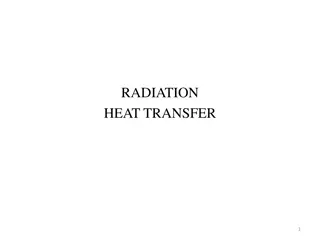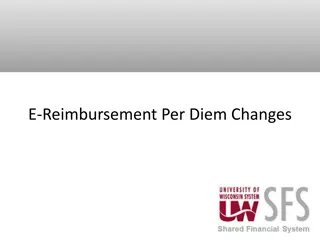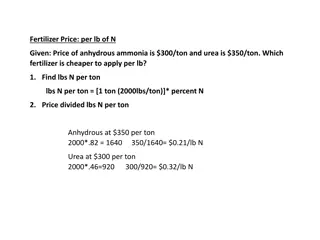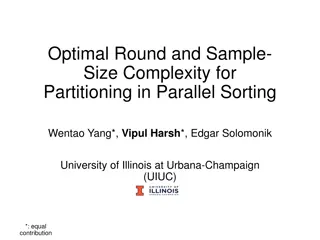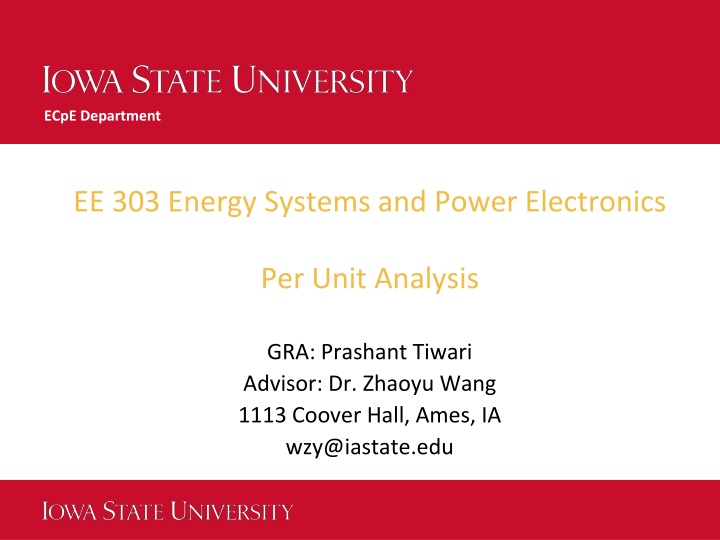
Per Unit Analysis in Electrical Energy Systems
Explore the concept of per unit analysis in the field of electrical energy systems and power electronics. Learn about normalization of variables, base values, and conversion of actual values to per unit. Discover how to analyze primary and secondary sides of transformers effectively.
Download Presentation

Please find below an Image/Link to download the presentation.
The content on the website is provided AS IS for your information and personal use only. It may not be sold, licensed, or shared on other websites without obtaining consent from the author. If you encounter any issues during the download, it is possible that the publisher has removed the file from their server.
You are allowed to download the files provided on this website for personal or commercial use, subject to the condition that they are used lawfully. All files are the property of their respective owners.
The content on the website is provided AS IS for your information and personal use only. It may not be sold, licensed, or shared on other websites without obtaining consent from the author.
E N D
Presentation Transcript
ECpE Department EE 303 Energy Systems and Power Electronics Per Unit Analysis GRA: Prashant Tiwari Advisor: Dr. Zhaoyu Wang 1113 Coover Hall, Ames, IA wzy@iastate.edu
Per Unit Analysis Motivation: It would be difficult to continuously refer impedance to the different sides of transformer. Mathematically, Actual Quantity Base value of the Quantity Quantity in Per Unit = 2 ECpE Department
Normalization of all variables S, V, Z & I (Note: Ohms law still holds) Pick ?? & ??, and calculate ?? & ?? ??= ?? ?? ?? ?? ?? ?? ??= = (Note: Base values are real numbers) ??2 ?? ??= ?? is for the entire system. ?? is for each different voltage level. Base voltages are related by transformer turns ratio 3 ECpE Department
Contd For a single-phase system: Step 1: Pick a single-phase base power for the entire system ??. Step 2: Pick a base voltage for each different voltage level, ?? o Base voltages are related by turns ratios. o voltages are line-to-neutral. ??2 ??. Step 3: Calculate base impedance, ??= Step 4: Calculate base current, ??=?? ?? 4 ECpE Department
Contd Step 5. Convert actual values to per unit (p.u.) Notes: 1) Base values are real numbers. Per unit conversion only affects magnitude, not angle. 2) Per unit quantities no longer have units. 5 ECpE Department
Contd V VB; P SB; Vp u= Pp u= Qp u= Rp.u= Xp u= S Q SB; SB; Sp u= R ZB; I IB; Ip u= X Z ZB.; ZB ; Zp u= 6 ECpE Department
Per Unit Values of Primary and Secondary Side of a Transformer are EQUAL ?2= ? .?1=?1 ? =?1 ? ?2 ?2=?1 ? =?2 ?= ?.?1 ?1 Transformation Ratio Real Values Choose Base Values: ?? ?1? & ?2?=?1? ?= ?.?1? 7 ECpE Department
Per Unit Values of Primary and Secondary Side of a Transformer are EQUAL Choose Base Values: ?? ?1? & ?2?=?1? ?= ?.?1? ?2 ?2? ? ?1 ? ?1? ?1 ?1? ?2,??= = = = ?1,?? ?2 ?2? ?2 ?? ?2? =?2? ?2 =? ?1? ?2 =? ?1? ? ?1 =?1? ?1 ??. ?1 ?? ?1? ?1 ?1? ?2,?? = = = = = ?1,??. ?? ?? ?? 8 ECpE Department
Per Unit Values of Primary and Secondary Side of a Transformer are EQUAL Choose Base Values: ?? ?1? & ?2?=?1? ?= ?.?1? 2 2 =?2 ?1? ?2?=?2? = ?2 ?1? ?? ?? ?2 ?? ?2 ?1? ?2 ?2? ?? ?1? ?2; ?.?= = = = ??; ?.?. 9 ECpE Department
Example 1 Q. Solve for the current, load voltage & load power in the following circuit using P.U. analysis with an ??= 100MVA and base voltage of ?B1= 8kV,??2= 80kV,??? ??3= 16kV. System Representation Actual Values 10 ECpE Department
Example 1: Solution ??1= 8kV; ??2= 80kV; ??3= 16k? (8 k?)2 100MVA= 0.64 . 80 k?2 100???= 64 . 16 k?2 100MVA= 2.56 . ??1 = ??2 = ??3 = Therefore, we can convert the actual values diagram in p.u. diagram. 11 ECpE Department
Contd 1 0 3.91+?2.327.= 0.22 30.8 ?.?. ? = ??= 1 0 0.22 ( 30.8 ) ?2.327 = 0.859 30.8 ?.?. = 0.189 ?.?. ??= ?? ?? = 1 0 0.22 30.8 = 0.22 30.8 p.u ??= ?? ?? 12 ECpE Department
Contd Convert back to actual values. ????????= 0.859 30.8 16?? = 13.7 30.8 ?? ??actual = 0.189 0 100??? = 18.9 0 ??? ??actual = 0.22 30.8 100??? = 22 30.8 ??? ?2?=100??? = 1250? 80?? ?2actual = 0.22 30.8 1250 ? = 275 30.8 ? 13 ECpE Department
Three- Phase Per Unit Analysis 3? Step 1: Pick a Three-phase base power for the entire system ?? Step 2: Pick a base voltage for each different voltage level, ??, ?? o L-L Base ??,?? o L-N Base ??,??/ 3 2 ??,?? 2 ??,?? ?? 3 3? Step 3: Calculate Base Impedance, ??= = 3? ?? 3 3? ?? 3? ?? 3??,?? 3?= 3 Step 4: Calculate Base current, ?? = ??,?? 3 Step 5: Convert actual values to p.u. 14 ECpE Department
Example 2: Solve for the current, load voltage and load power in the previous circuit, assuming a 3 base power of 300 MVA, and line to line base voltages of 13.8 kV, 138 kV and 27.6 kV (square root of 3 larger than the 1 example voltages). Also assume the generator is Y-connected so its line-to-line voltage is 13.8 kV. ??1= 13.8??,??2= 138?? ??? ??3= 27.6 ?? 15 ECpE Department
Example 2: Solution Convert to per unit as before. Note the system is exactly the same as example 1! 1.0 0 3.91+?2.327= 0.22 30.8 p.u. (not amps) ? = ??= 1.0 0 0.22 30.8 2.327 90 = 0.859 30.8 p.u. ??2 ? = = 0.189 p.u. ??= ???? 16 ECpE Department
Contd ??= 1.0 0 0.22 30.8 = 0.22 30.8 p.u. Again, analysis is exactly the same Difference appear when we convert back to actual values ????????= 0.859 30.8 27.6?? = 23.8 30.8 ?? ??actual = 0.189 0 300??? = 0.567 0 ??? ??actual = 0.22 30.8 300??? = 0.66 30.8 ??? 300??? 3 138??= 1250? (same currents) ??Middle= actual = 0.22 30.8 1250 ? = 275 30.8 ? ??????? 17 ECpE Department
Example 3 ? ? ?????= 10 + ?100 ?????= 300 13.2 kV 10 MVA 13.8 kV- 69 kV ??2= 8% = 0.08p.u. 5 MVA 13.2 kV- 132 kV ??1= 10% = 0.1p.u. Q.Find the equivalent p.u values of each component. 18 ECpE Department
Example 3: Solution ? ? ?????= 10 + ?100 ?????= 300 13.2 kV 10 MVA 13.8 kV- 69 kV ??2= 8% = 0.08p.u. 5 MVA 13.2 kV- 132 kV ??1= 10% = 0.1p.u. 3?= 10 MVA ?? L L= 69 kV ?3? L L= 138 kV ?2? L L= 138 kV 13.2k? ?1? 132k?= 13.8kV 19 ECpE Department
Example 3: Solution ? ? ?????= 10 + ?100 ?????= 300 13.2 kV 10 MVA 13.8 kV- 69 kV ??2= 8% = 0.08p.u. 5 MVA 13.2 kV- 132 kV ??1= 10% = 0.1p.u. 3?= 10 MVA ?? L L= 13.8kV L L= 138 kV ?1? ?2? L L= 69 kV ?3? L L2 =692 10= 476 ?3? ?3?= 3? ?? L L2 =1382 10 ?2? ?2?= = 1904 3? ?? ?1? L L2 =13.82 10 ?1?= = 19.04 3? ?? 20 ECpE Department
Example 3: Solution ? ? ?????= 10 + ?100 ?????= 300 13.2 kV 10 MVA 13.8 kV- 69 kV ??2= 8% = 0.08p.u. 5 MVA 13.2 kV- 132 kV ??1= 10% = 0.1p.u. 3?= 10 MVA ?? L L= 13.8kV L L= 138 kV ?1? ?2? L L= 69 kV ?3? L L2 =692 10= 476 ?3? ?3?= 3? ?? L L2 =1382 10 ?2? ?2?= = 1904 3? ?? ?1? L L2 =13.82 10 ?1?= = 19.04 3? ?? 21 ECpE Department
Example 3: Solution ? ? ?????= 10 + ?100 ?????= 300 13.2 kV 10 MVA 13.8 kV- 69 kV ??2= 8% = 0.08p.u. 5 MVA 13.2 kV- 132 kV ??1= 10% = 0.1p.u. ?load=350 476 = 0.63 p.u. ?line=10 + j100 = 0.005 + j0.05 p.u. 1904 ??=13.2k? 13.8k?= 0.96 p.u. 22 ECpE Department
Example 3: Solution ? ? ?????= 10 + ?100 ?????= 300 13.2 kV 10 MVA 13.8 kV- 69 kV ??2= 8% = 0.08p.u. 5 MVA 13.2 kV- 132 kV ??1= 10% = 0.1p.u. ? ? 2 ? ? 2 0.08 ?3? 0.08 ?3? 3? 3? ?? ?? ?L2= = = 0.08 ? ? 2 ?3? ?3? ?? 3? 0.1 13.2kV2 5 MVA ?1? 0.1 13.22 5 ?L1= = = 0.183 p.u 13.82 10 23 ECpE Department
Example 3: Solution ? ? ?????= 10 + ?100 ?????= 300 13.2 kV 10 MVA 13.8 kV- 69 kV ??2= 8% = 0.08p.u. 5 MVA 13.2 kV- 132 kV ??1= 10% = 0.1p.u. 0.1 13.2kV2 5 MVA ?1? 0.1 13.22 5 ?L1= = = 0.183 p.u 13.82 10 Alternatively, we can find ?L1 as, 0.1 132kV2 5 MVA ?2? 0.1 132 kV2 5 MVA 1382 10 ?L1= = = 0.183 p.u 24 ECpE Department
Thank You! 25 ECpE Department


